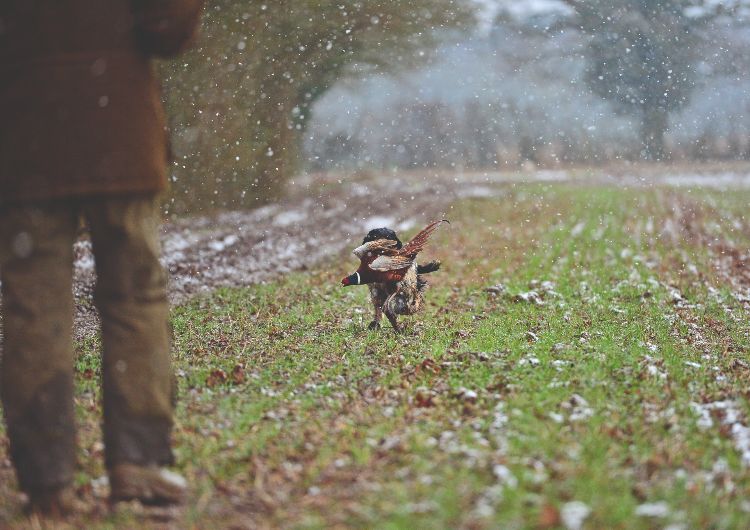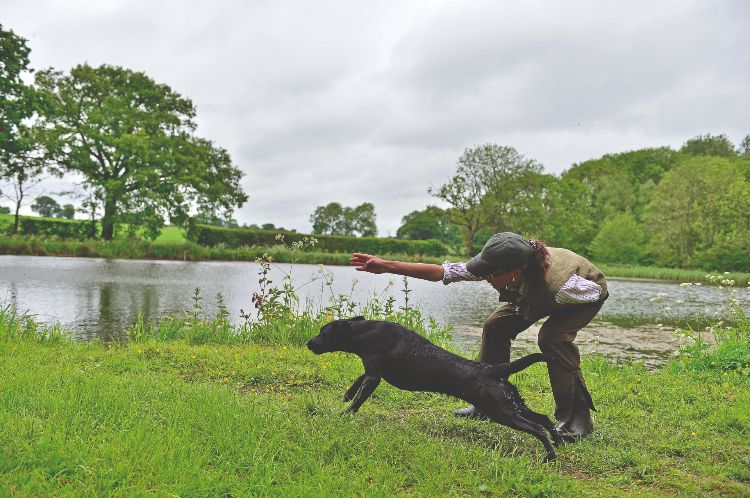Having judged and overseen a few working tests during the summer period, it got me thinking about handlers and the decisions and subsequent actions that we take whilst our dogs are out on a retrieve. I think it’s important to highlight that we usually get involved with stopping and directing a dog at the point where things are starting to go wrong. As soon as we stop the dog, it’s now doing the equivalent of a blind retrieve. Initially the dog may well have been given a mark. Our original plan was to get the dog to the fall, in one cast. If this doesn’t happen, then from here on in, we are handling onto a dummy or bird that the dog didn’t find on its own.
Training for success
Living in the real world, it’s plain naïve to assume that we won’t need to handle and direct our dogs onto retrieves. But there are things we can do to reduce the need to handle the dog at distance. My start point being that, whenever possible, we should aim to get the dog to the bird in ONE cast.
Rather than follow the normal route, which would be to focus on the dog, I’m going to explore the things that we, as handlers, might need to consider, and how we can develop the skills set required to successfully handle a dog at distance.
 Measuring distance
Measuring distance
Distance perception is something that some people are naturally good at and others really struggle with. Those that regularly practice throwing and setting dummies will already have lots of visual references to draw on.
It’s not uncommon for me to hear a handler say, “oh I don’t do distances”. The ‘impatient coach’ in me screams, (internally), “what?! In a sport where Guns, peers and judges will regularly give you a mark using distances, you choose not to address this?” Then the grown-up in me arrives, and I suggest we start to look at improving this essential skill.
One of the extra things to factor in is whether or not the person giving you a distance is reliable in their own judgment. Make it your business to quietly check distances that are offered to you by fellow handlers. You’ll soon figure out whose ‘marks’ you can trust.
Here are a few easy ideas that you might use to develop your ability to assess and judge distance...
Developing your ability to judge distance
Start by getting yourself a tape measure. Most verbal measurements are offered in yards or metres. These measurements are slightly different, but when used in the field, are usually close enough for you not to worry whether you’re offered instructions using yards or metres (100 metres = 109.361 yards). Get yourself some marker poles and mark out a start point (or better still a handling box) then mark out 25, 50, 75 and 100 metres or yards. Put the poles in a straight line, ideally alongside a retrieving corridor, path or track.
Whilst we are busy making measurements, take the opportunity to calibrate 10 of your paces. As a rough guide, one fairly large human pace is approximately one metre. We’re all different so
get pacing! The new gundog trainer in you is going to be doing a lot of pacing up and down. For some, the process of measuring and establishing what these distances look like will be hugely beneficial.
Stand at the 0-metre mark and deliberately cast your eyes up and down each pole, making a mental note of what a pole looks like at 25/50/75 and 100 metres. What we’re learning here is what a pole at varying distances looks like, importantly though, from a human’s eye view (I know! You were hoping life would be more exciting than this!).
Now sit on the floor and do the same exercise from the dog’s point of view. Variations in cover heights will, of course, be hugely influential in determining what a dog can see.
Repeat this exercise by putting a dummy on the ground at all four distances and again train your brain to recognise these sight pictures. Now, have a friend stand at each marker and throw a dummy up in the air. Remember to look at each stage from the dog’s eye line.
Now that you have started to take an interest in distances you can begin to test yourself. Look at a tree, fence post, person and, really importantly, a dog. Estimate the distance and then pace out the true distance to the object.
Every time you walk out to set a dummy, pace it out. Make a conscious effort to look and memorise what you see, glance back to where you left the dog on a sit/stay, squat down and take a dog’s eye view back to where you’ll be standing when you cast the dog. Visualise and try to process what you see. In a nutshell, we need to be really good at accurately estimating distances.
 Putting it into practice
Putting it into practice
I have deliberately made the beginning of this article about us and our ability to accurately put a number to any given distance. This is just the beginning. With regular study, we can arm ourselves with the skills needed to accurately mark the fall of a dummy or bird. Having done that, we now need to file this visual sight picture away. Sometimes seconds and often many minutes later we will need to recall ‘the file’ and communicate it to our dogs.
Make it important to you. Remember the handler that says, “oh I don’t do distances”? Let’s turn that into a positive. How about starting with: “I’m not great at distances, but I’m jolly well going to make it my business to be better.” Those that have this skill, already have an advantage.
This skill is so important because, without it, you will be giving directions, mostly wrong, to a dog that will either quickly fall apart as a direct result of your highly confusing instructions, or just decide that taking instruction from you is a waste of time and go ‘self-employed’. Both are disastrous but if you ever get to see the former, it’s at the very least depressing.
Whilst we’re talking instructions and direction, remember, hunting is the dog’s department. Hold that thought! You’ll need to think about it every time you choose to work alongside a dog.
So, I’ve waffled on about improving our skills. It’s really easy to fall into the trap of wanting to learn all of the ‘shiny’ bits at the expense of the more ‘mundane’ – but this is a mistake. One day, when we can do a three-year degree in Training a Dog for the Shooting Field, my classes will start with dummy throwing, ball catching and judging distances. I bet you’re thinking, thank goodness Kirby’s never going to be in that position!
Estimating distance. Food for thought. Get measuring!